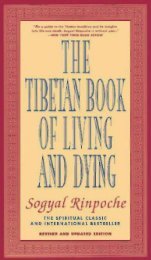Mandukya_Upanishad
Mandukya_Upanishad
Mandukya_Upanishad
You also want an ePaper? Increase the reach of your titles
YUMPU automatically turns print PDFs into web optimized ePapers that Google loves.
The dream consciousness which is taijasa has certaincharacteristics of Viśva, also. The subtle body has the samecontour as the physical body. If the physical body is a form,the subtle body is the mould in which this form is cast. Thesubtle body has, thus, a reference to the physical body, and,almost in every respect, it corresponds in form, shape andstructure to the physical body. This is why the words,saptānga and ekonavimśatimukha, are repeated, both inthe waking and the dream descriptions.The Viśva, or the jāgaritasthāna, is saptānga andekonavimśatimukha; and so is taijasa, or the svapnasthāna.Hiraṇyagarba and Virāt seem to have the same structuralformation, though hiraṇyagarba is subtler than Virāt.Hiraṇyagarba and Virāt are both cosmic, and theirdifference is one of a degree of subtlety, but not ofstructural formation. Hiraṇyagarba also would be beheld byus in the state of realisation as the Virāt only with thedistinction that hiraṇyagarba is subtler than the Virāt. Theseven heads described of Viśva or Vaiśvānara can also bedescribed as of hiraṇyagarba or taijasa. taijasa individuallyand hiraṇyagarba cosmically are antahprājña, internallyconscious because of their objects being not physical butsubtle, constituted of tanmātrās: śabda, śparśa, rūpa, rasaand gandha. Though waking and dream have theirsimilarity of character in respect of saptāngatva andekonavimśatimukhatva, the dream consciousness ispraviviktabhuk, both individually and cosmically, it absorbssubtle things into itself in both cases. And that distinctionwe draw between Viśva and Vaiśvānara, we can also drawbetween taijasa and hiraṇyagarba. The relation between the79



